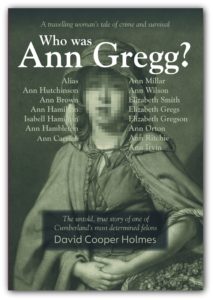A travelling woman’s tale of crime and survival as uncovered by descendant
By James Pylant | Posted 25 June 2018
 As a child, David Cooper Holmes often spent weekends and school holidays with his grandmother at her home in Seaton, in England’s northwest county of Cumberland. He remembers her as strong, strict, and dominant; yet, she was special in that she “did things my friends’ grandmothers never did.” During his teen years in the late ‘60s, Cooper Holmes’s visits with his grandmother lessened as he began traveling on weekends—typically hitchhiking his way to pop concerts. “When I visited my gran and told her about all my adventures, she gave me her stern look and, wagging her finger, she said, ‘You’ve got too much gypsy blood in you!’”
As a child, David Cooper Holmes often spent weekends and school holidays with his grandmother at her home in Seaton, in England’s northwest county of Cumberland. He remembers her as strong, strict, and dominant; yet, she was special in that she “did things my friends’ grandmothers never did.” During his teen years in the late ‘60s, Cooper Holmes’s visits with his grandmother lessened as he began traveling on weekends—typically hitchhiking his way to pop concerts. “When I visited my gran and told her about all my adventures, she gave me her stern look and, wagging her finger, she said, ‘You’ve got too much gypsy blood in you!’”
Years after her death—and after Cooper Holmes delved into family history—he realized that his grandmother’s “gypsy blood” comment was literal. At first, his genealogical notes were what he calls “just names on paper.” His grandmother had died leaving no stories of her past. But as his interest grew, he began taking notes of his ancestors’ occupations. He found that his grandmother was the daughter of a hawker (a travelling seller or peddler), the same trade popping up in records for other family members as they spread over Cumberland, Westmorland, North Lancashire, and North Yorkshire. They were potters, pot hawkers, or earthenware dealers who followed the trades and traditions of Gypsies and Irish Travellers. What started as “just names on paper” turned into an unexpected adventure.
David Cooper Holmes’s journey through the generations trailed to his five-times great-grandmother, the subject of his book, Who was Ann Gregg? Born in Cumberland in 1756, Ann Gregg was the daughter of a traveling tinker. A few years before her birth, newspaper accounts told of two relatives (members of the notorious gypsy “Gang of Faws”) who were transported to America on a convict ship. The Greggs, Cooper Holmes found, were fearless of the law. “In their desperately poor situation, food and simple surviving came before anything else,” he explains.
Ann Gregg married William Hutchinson and gave birth to 13 children, but she also was a serial petty felon. In this 216–page book, the author uncovered Ann’s 14 aliases, frequent moves around the four northern counties of England, her incarcerations in at least seven different jails and prisons (escaping four times). He tirelessly tracked cousins in England and Scotland as well as Australia, New Zealand, Canada, Mexico, and the U.S., collecting some 40 to 50 DNA samples to sift through the layers of aliases and confirm genealogical conclusions drawn from the paper trail. Who was Ann Gregg? is well-interspersed with documents and newspaper accounts for its subject (as well as her family and social connections), painting a stark portrait of life in and out of prison.
Who was Ann Gregg? The Untold, True Story of One of Cumberland’s Most Determined Felons. By David Cooper Holmes. Published by P3 Publications, Carlisle, Cumbria, England. Paperback (2019), U.S. $13.56. Available online from www.bookdepository.com.
Book Review and Material Connection Disclosure: GenealogyMagazine.com receives complimentary copies of books with the understanding that they will be considered for review without compensation. We are disclosing this in accordance with the Federal Trade Commission’s 16 CFR, Part 255: “Guides Concerning the Use of Endorsements and Testimonials in Advertising.”
